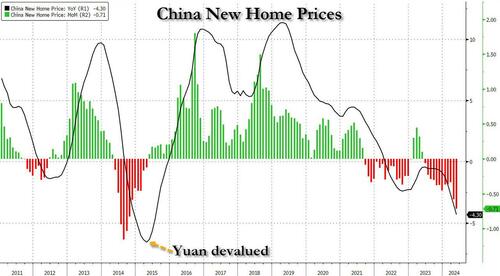Holding And Hoping
By Bnejamin Picton, Senior Macro Strategist at Rabobank
Holding and Hoping
US stocks reset record highs overnight as the NASDAQ rose 1.25% and the S&P500 closed up 0.77%. Even European stocks shook off the turmoil of the last few days to close higher. The EuroStoxx 100 was up 0.85%, the DAX rose 0.37% and the CAC40 rebounded from steep losses last week to close up 0.91%.
Oil prices also posted gains with Brent crude up 2.2% to trade back above $84/bbl and WTI closing above $80/bbl. Spot gold sold off 0.58% to $2,319/oz, which may have come as a result of 10-year Treasury yields rising by more than 6bps to 4.27% while the 2-year yields posted similar gains to see the sovereign curve parallel-shift higher. French bonds outperformed Bunds after Marine Le Pen said that she was not seeking “institutional chaos” and was willing to work with Emmanuel Macron if her RN party is as successful in upcoming elections as recent polling suggests.
Overall, yesterday’s price action looks very much like a garden variety risk-on move.
The day ahead will be dominated by the RBA’s June policy rate decision, the publication of the German ZEW survey and the release of May retail sales figures for the United States. The RBA is widely expected to leave the cash rate unchanged at 4.35%, so traders will mainly be searching for signs of an amping up of the Aussie central bank’s minor hawkish bias in the Decision Statement or Governor Bullock’s subsequent press conference.
Rabobank maintains a contrarian forecast on the next move from the RBA being a hike rather than a cut (in fact, we are forecasting two hikes this year). We adopted that forecast following the upside inflation surprise in Q1, which gelled with signals from Australia’s positive output gap, a labour market operating beyond full employment, rising asset prices, accelerating credit growth (which never recaptured the 2019 lows), PMIs back in expansion, a gradual improvement in consumer confidence since early 2023, virtually non-existent productivity growth and subsequent monthly inflation readings that showed the RBA’s favoured core inflation measure drifting higher.
The RBA also has to contend with a fiscal stance that is swinging from mildly contractionary to unambiguously expansionary. The Australian Federal budget included $24bn/year worth of income tax cuts and $10bn worth of additional spending in 2024/25. Additional spending and lower receipts will see the current fiscal year’s small surplus transform into an expected $28bn deficit next year. At the state government level, the purse strings have been loosened even further as a number of long-in-the-tooth administrations throw the proverbial kitchen sink at campaigns for re-election. Australia’s three most populous states are all forecasting large operating deficits in the year ahead. Two of those had previously been forecasting small operating surpluses, so the fiscal pendulum has certainly swung.
The futures market does not agree with our view on Aussie rates. RBA-dated OIS suggests that the cash rate will remain unchanged for the duration of 2024, with a 95% chance of a rate cut at the February policy meeting. It would be remiss of me not to note that there are plenty of arguments in favour of that view. Annual GDP growth of just 1.1% in Q1 was well below conventional estimates of potential growth (2.5% p.a.), and suggests that the output gap is narrowing, while labour market lead indicators (job ads, for instance) continue to show ongoing gradual deterioration – albeit from a generationally strong starting point.
China’s economic performance has an outsized bearing on Australia’s fortunes. Data released yesterday again confirmed ongoing weakness in the Chinese real estate sector, as new home prices fell 0.71% in May, used home prices fell 1%, residential property sales declined 30% year-on-year and the PBOC kept the 1-year MLF rate unchanged at 2.50%. Consequently, SGX iron ore futures and LME copper both finished lower on the day, which is bad news for Australia’s terms of trade.
The June ZEW survey is expected to show further improvement for both the ‘expectations’ and ‘current situation’ readings, continuing a developing theme of things starting to look better for Europe (at least economically). The expectations index has been rising since late 2022, and the consensus estimate of economists surveyed by Bloomberg suggests that it will rise another 2.9pts to a 50 reading today. The ‘current situation’ index has been tracking broadly sideways since October of last year, but surveyed economists expect a pickup to -65 from last month’s -72 reading. With the ECB having recently delivered the first cut of an expected easing cycle, the hope will be that assessments of the current situation begin to converge on the much more upbeat view of the road ahead.
US retail sales are expected to rebound from a -0.3% month-on-month slump in April to post growth of 0.5% in May. Signs of resilience in retail spending would justify the caution of Philly Fed President Harker, who commented yesterday that the Fed needed to wait for several more months of data before cutting rates. Harker said that the softer-than-expected May CPI result was encouraging, but not sufficient, and that one rate cut in 2024 would be appropriate based on the current outlook. That’s a little more conservative than Rabobank’s house view on the Fed Funds rate. We expect the Fed to cut rates in September and December as the US economy softens into a mild recession in the final quarter of the year.
Tyler Durden
Tue, 06/18/2024 – 10:40

